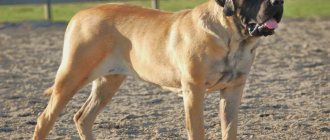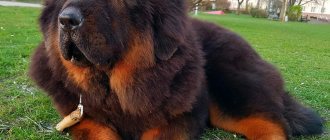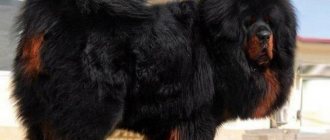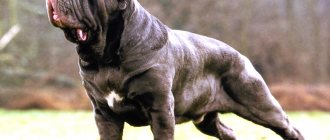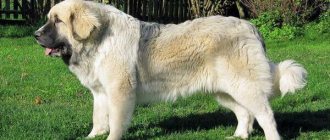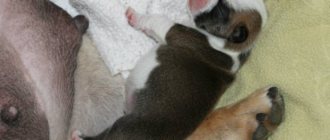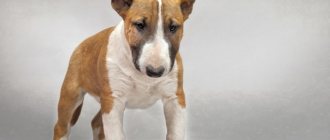History of the English Mastiff breed
English mastiffs cannot boast of a reliable version of their origin.
The history of their existence dates back more than one millennium, and it is difficult for modern dog handlers to establish which of the two theories is correct. The first says: “English” descended from Molossoid type dogs - massive and hardy animals that were bred to hunt big game or organize gladiator fights. The second version confirms the original English origin of the animals. It is known that mastiff-like dogs existed back in the era of prosperity of the ancient states - Persia, Greece, Egypt and Babylon - and were quite popular among representatives of the nobility and ordinary people. Mastiffs were widely used as draft power, as well as for baiting wild boars, wild horses and even large predators - tigers and lions. In their free time from hunting, the dogs successfully coped with the protection of property and livestock.
No less important was the participation of animals in bloody wars. Mastiff-like dogs were valued on par with well-trained soldiers. Historical documents have been preserved that confirm the existence of the canine “army” of Alexander the Great, which included about 50 thousand animals! These four-legged ferocious warriors struck fear into the enemy army, forcing it to raise the white flag ahead of time. With the help of dogs, the commander conquered Persia in the 5th century BC. e. and acquired a new title - King of Asia.
The ancestors of the English mastiff were also kept by another military leader - Gaius Julius Caesar. Animals were brought to the Roman Empire in the second half of the 1st century BC. e. Before this, the commander’s legions landed on the territory of Britain, where they became acquainted with huge dogs. According to Roman soldiers, the animals resembled lions in their size and had an equally ferocious disposition. These dogs are descended from Babylonian mastiffs, which came to Britain along with Phoenician merchants long before the emergence of the all-powerful empire.
The Romans were conquered by the fury and power of animals: in comparison with them, Caesar's Molossians looked docile and harmless. After the capture of the state, the legions set off on the return journey, taking with them more than a dozen mastiffs. Since then, more impressive British dogs appeared in the fighting arenas of Rome, which always ensured a spectacular victory over wild animals.
After the collapse of the empire, the dogs did not lose their popularity. Over time, they spread throughout Europe, forming small groups, from which new breeds were later formed - in particular, the Great Dane and the Dogue de Bordeaux. British dogs changed their role, settling in the royal guards and hunting grounds of aristocrats. Commoners were forced to refuse to keep these animals due to their enormous size: feeding such a dog is not an easy task.
The peak of popularity of mastiff dogs came in the first half of the 13th century, when it became known about the unusual act of a fighting bitch that belonged to the English nobleman Sir Peer Lee. She became famous for fiercely guarding the body of her wounded owner during the battle of Agincourt until reinforcements arrived in the city. Then they looked at the animals differently, noting not only their outstanding physical characteristics, but also their amazing devotion. It was the latter that became the starting point after which the first kennel of Molossian dogs arose in Britain. The English line of the breed originated from Peer's favorite. The aristocrat's gratitude was so great that he raised all his dog's puppies and took care of their future fate. In addition, Sir Lee took an active part in the life of the new nursery.
People's idea of mastiffs changed during the Renaissance. Queen Elizabeth I, who was famous for her love of cruelty and bloodshed, strongly encouraged animal fighting. For this, the Molossian dogs turned out to be quite clumsy. Crossing them with bulldogs produced ideal candidates for the dog pits. From these animals a new breed later emerged - the bullmastiff.
Baiting four-legged gladiators became the favorite “sport” of the British. The fights between mastiffs and bears and bulls were especially spectacular. The dogs' willingness to fight to the last drop of blood made them fertile ground for opening an underground betting shop. Private breeders were actively involved in animal breeding until the 15th century, when bulldogs completely ousted Molossian dogs from the bloody arena. They began to forget about the existence of mastiffs. The ban on violent entertainment in 1835 only made matters worse. In the second half of the 19th century, the number of English Molossians decreased so much that the breed was on the verge of extinction.
This would have happened if not for the intervention of mastiff lovers. By joining forces, they created the first public club, which controlled the selection of dogs in order to increase their number and maintain the purity of the breed. The result of the well-coordinated work of volunteers became noticeable already in 1873, when one of the club’s “pupils” - a dog named Tauras - won a victory at an international exhibition. Subsequently, this mastiff actively participated in recreating the Molosser population. Among all the puppies, only one was remembered - Crown Prince: he was recognized as the only champion of the breed. From this dog came the main line of the English Mastiff that exists to this day.
With the outbreak of the First World War, the fate of the Molossians was in jeopardy. Hungry times came, and such huge animals became burdensome. Keeping dogs that ate as much as army soldiers was considered highly unpatriotic. Animals were euthanized en masse, so only a few mastiffs managed to survive. Events of 1939-1945 These “crumbs” were also destroyed. By the middle of the 20th century, the number of Molossians did not exceed fifteen individuals. Among them was the only female capable of reproducing offspring. This gave a ghostly chance for the breed to be revived again.
Nora Dicken had the same strong “grip” as her beloved English mastiffs. In search of surviving dogs, the woman went to Canada and the USA, where she acquired the last representatives of the breed, found several sponsors and began painstaking breeding work on breeding animals.
Miss Dicken's success is best demonstrated by the official recognition of mastiffs by the English Kennel Club (UKC) in 1948. Breeders continued to adhere to the strategy of inbreeding - closely related mating of animals. For this reason, dogs have acquired an impressive list of genetic defects. We managed to get rid of them partly thanks to successful breeding work. Modern representatives of the breed are healthier.
Now in the character of massive dogs one can hardly notice the bloodthirstiness of their ancestors. Mastiffs of England occupy the 27th position in the list of the most popular breeds in the USA: these animals make excellent companions and loyal friends.
History of the breed
The English Mastiff breed originated more than 1000 years ago. The homeland of these giant animals is Great Britain. They came from old English Molosser dogs. Until the beginning of the nineteenth century, English mastiffs were at the peak of their fame and popularity. They were worth their weight in gold. For example, if an exchange was made between the owners of working dogs, then two dozen hounds and greyhounds would be traded without regret for one huge and angry mastiff.
The popularity and fabulous price of the mastiff is explained by the fact that the owner of such a dog did not have to worry that thieves would get into his possession. A more reliable guard could not be found, he scared off all the thieves in the area with his mere appearance, he didn’t even need to bark for this. It is known that such dogs were kept at fortresses and castles.
Also, those who wanted to make money on their powerful pet took full advantage of the fact that a mastiff, once involved in a fight, never retreats, even if this threatens its death. These dogs were pitted against wild boars, bears and even bulls. There are cases when both opponents died at the same time in a fight. For example, if a mastiff squeezed the bear’s throat with its fangs in a death grip, the bear, in its death throes, tore the skin off the dog with its claws. English mastiffs were also noted as fighting dogs in the Roman army and as hunting dogs.
The English Mastiff breed is so ancient that it has not been possible to reliably establish its origin. One of the most realistic versions “claims” that these large dogs came to England along with the Celts. The main purpose of mastiffs was to participate in fights with wild animals and the guard and guard qualities of these animals.
Breeding purebred English mastiffs was at its height in the 15th century. It was during this period that many images and descriptions of these dogs were found in works of art. At the beginning of the nineteenth century, the fashion for mastiffs decreased somewhat, this can be explained by the ban on dog fighting. After this, mastiffs practically disappeared; people were afraid to have such aggressive dogs. Powerful mastiffs could not provide winnings to their owners, but they were fully capable of protecting property.
By the mid-twentieth century, the English Mastiff population had been restored. In the modern world, they are used as bodyguards, guard dogs, and also regular companion dogs. It is considered to be one of the most popular dog breeds.
Appearance of the English Mastiff
The English Mastiff is a large breed. Despite its size, the dog looks proportional. Female individuals are more graceful and light, the gender type of the animal is clearly pronounced.
The parameters defined by the breed standard are impressive. The height of females at the withers reaches 69 cm and higher, the height of males starts from 76 cm. As for body weight, it reaches 68 and 72 kg, respectively. The weight of individual dogs can be 86 kg.
Head and skull
The width and length of the mastiff's head is in the ratio of 2:3, which determines its square format. The muscles are pronounced (especially in the cheeks, temples and crown). The outlines of the skull are smooth. The occipital protuberance is smoothed, while the forehead and brow ridges protrude forward.
Muzzle
The ratio of the length of the muzzle to the skull is 1:2, and their lines are parallel to each other. Rectangular format. The muzzle circumference is 2.2 times less than the head circumference. The stop is slightly expressed, a small depression in its central part reaches the middle of the forehead. This is also where wrinkles appear when the mastiff is focused or alert. The cheeks are round, the cheekbones practically do not protrude. The nose is flattened in a horizontal plane, pigmented black, and has movable and wide-open nostrils. The dog's thick and fleshy lips are rectangular in shape: this is noticeable when the animal is turned in profile. Painted black, adjacent to the jaws. A “mask” is visible on the dog’s face.
Ears
The thin, hanging ears of the English Mastiff are of medium length, set almost on the top of the head and set far back to the sides of the head. They look like regular triangles with rounded tops. They are distinguished by an inclination forward, adjacent to the dog’s cheeks.
Eyes
The “Englishman’s” eyes are set low, at a considerable distance from each other. The iris is colored in a light or dark shade of nut color. The breed standard gives preference to the latter option. The eyelids are adjacent to the eyeballs. The mastiff's look seems good-natured and soft because of the “glasses”.
Jaws and teeth
The square-shaped jaws form a scissor or level bite. The teeth are healthy white. The lower incisors are arranged linearly or in a checkerboard pattern. Powerful fangs set wide apart. When the mastiff closes its mouth, its teeth are not visible due to the tightly fitting lips.
Neck
The slightly arched neck of the “Englishman” is characterized by medium posture and lean muscles. Its circumference is 2-3 cm smaller than the circumference of the skull. The skin is dense and forms symmetrical folds only on the dog’s throat.
Frame
The English Mastiff has a powerful and elongated body. The deep chest of the animal is formed by convex ribs, lowered to the level of the elbows. The anterior protrusion of the sternum is extended beyond the shoulder joints. A straight and wide back begins from the withers. The loin rises slightly above it, the croup is sloping. The lines of the abdomen and groin are tightened.
Tail
Set high, tapering from base to tip. It has a crescent shape. When in motion it is carried at the level of the back; at rest reaches the hock joints of the dog.
Forelegs
Outlined by muscles, located at a considerable distance from each other. The lines of the elbows and chest form a slight angle. Obliquely set shoulders turn into sheer forearms, and those into massive pasterns. The large paws are round in shape and the toes are gathered.
Hind limbs
Muscular thighs turn into dry shins. The joints are pronounced, short metatarsals are distinguished by an almost vertical set. The paws are arched, the toes are gathered into a ball.
Movement style
The English Mastiff moves at a heavy trot, which turns into a gallop as the dog's speed increases. Movements are free, sometimes they look “loose.” Regardless of the pace, the animal keeps its back straight.
Coat
Representatives of the breed are covered with thick and short hair that fits tightly to the body. It feels harsh to the touch, especially in comparison with the thicker undercoat.
Color
The English Mastiff is characterized by a tan color. The main tone is represented by brindle, silver, apricot, fawn and yellowish-brown variants. Regardless of coat color, the ears are always black. The same applies to the “mask” on the dog’s face.
Possible defects
Among the defects of the breed are:
- discrepancy between the gender type and the sex of the animal;
- swaying of the croup in a horizontal plane;
- bulging and/or close-set eyes;
- shortened or elongated muzzle;
- pronounced bend of the bridge of the nose;
- long and/or wavy hair;
- shallow and/or flattened breasts;
- presence of a white spot on the chest;
- excessive dental formula;
- nervous and timid behavior;
- light shade of the iris;
- weak muscles;
- elongated paws;
- light “mask”;
- convex back;
- plaque on teeth;
- clubfoot.
The English Mastiff is disqualified for the following faults:
- melancholic or unreasonably aggressive behavior;
- long or short ears, their atypical color;
- light or excessively rough physique;
- pronounced cheekiness or cheekbones;
- partial or complete absence of undercoat;
- stretched or square case format;
- tail bent or curled into a ring;
- sharp or completely smoothed stop;
- strongly prominent occipital protuberance;
- partial pigmentation of the nose and lips;
- an angry and expressionless look;
- long wavy coat;
- lack of eye rims;
- asymmetrical “mask”;
- domed head;
- uneven color;
- heterochromia;
- flakiness;
- amble;
- caries.
For male dogs, cryptorchidism is unacceptable - failure of the testicles to descend into the scrotum.
Breed standard
The English Mastiff dog is one of the heaviest and tallest. Puppies grow up very quickly, gradually increasing their weight. The weight of an adult dog is from 80 to 85 kg, and the height is from 68 to 75 cm (males weigh more than females). The dog has a wide back, pronounced croup and loin. The body is elongated and powerful. Every muscle on the animal’s body is perfectly developed.
He has a wide and well-defined sternum. The rounded wide ribs are clearly visible on the stomach. The tail is sickle-shaped and set high. Usually it is motionless, but when the dog moves, it rises up. The stance of the high legs is parallel and straight. Rendered muscles run along the entire length of the limbs, with the hind muscles being especially well developed.
Lumpy paw pads. The claws are black and sharp. The dog's neck is short and its head is large. There are folds of skin on the throat. The jaw is powerful and well defined. The cheeks are thick and massive. According to the standard, the animal's lips should be black, and the front of the gums should be visible from its mouth, even if it is closed.
The head shape is square. The forehead is well defined. The cheekbones do not lean forward, but are clearly visible. When a dog is concentrating on something, many folds of skin form in the area of its forehead. There are also brow ridges. The nose is flattened, but large, dark in color. The bite of the teeth is correct.
The English Mastiff in the photo looks serious due to his deep-set dark eyes. They are covered from above by a dense fold of skin. On the animal's face, the eyes are located far from each other. The dog has short hair that is rough to the touch. There is an undercoat, it is softer. Representatives of the breed are characterized by the following color variations:
- Red-black (most common).
- Apricot.
- Brindle.
- Silver with tan marks.
Mastiffs have a calm and balanced character.
The Great Dane moves very confidently, slowly. Let us list the defects of the breed:
- Ears sticking up.
- Absence of a “mask” on the face.
- Lack of pigmented areas on the lips and nose.
- Different color.
- Tongue protruding from a closed mouth.
- Height below or above the 85 cm mark.
- Blue eyes.
Character of the English Mastiff
There is no trace left of the English Mastiff's fighting past. Modern representatives of the breed are calm and friendly dogs that show amazing constancy before mood swings. The character of these animals shows the traits of people from Old England: tolerance, reliability and greatness. The Mastiff knows his worth, never stoops to puppyish pranks and behaves with such nobility that one involuntarily recalls individuals of royal blood. At first glance, the dog seems to be an inveterate phlegmatic, but this is not so. Deep down, the “English” have an amazing love for their family members.
The affection of mastiffs can be aggravating (literally): these dogs love strong hugs, so at the slightest opportunity they will jump into their owner’s lap. Considering the weight of the animal, you should forget about strength training in the gym: it’s enough to “nurse” a pet weighing 70 kg!
English Mastiffs need constant care about this. If your work schedule or hectic lifestyle does not allow you to spend time with your dog, it is better to give up the desire to have a representative of this breed. Loneliness is the worst punishment for mastiffs. In desperation, the animal will try to entertain itself on its own, and this will in any case cause damage to your apartment.
The “English” are inveterate homebodies, absolutely not inclined to run away. When letting your pet off the leash in a deserted park, you don’t have to worry: the mastiff will always come back to you, no matter how interesting and exciting the surroundings seem to him.
Although representatives of the breed are considered trembling and gentle giants, they cope excellently with guard duties. The dog's protective instinct extends not only to the territory, but also to members of its family. Having met an uninvited guest, a mastiff will never rush to attack first: its impressive size is more than enough. Most likely, the animal will drive the stranger into a corner, where it will “leave” him until the owner returns. However, if it comes to a fight, the dog will never yield to the enemy, even at the cost of his own life.
The mastiff is no less wary of strangers. The animal almost never makes contact with strangers. Moreover: the “Englishman” will stand between him and the owner until he is convinced that there is no danger. Even frequent guests in your home will not be able to escape the gaze of the mastiff, ready to rush to defense at any moment. Dog attacks are extremely rare, so the only thing you should be wary of is the lack of free space on the sofa. The mastiff usurps this “territory” in the most brazen manner.
“English” is not suitable for families with small children, largely due to its size. In the midst of a fun game, an animal may accidentally push the baby and cause injury. If you are unshakable in your conviction to have a four-legged friend for your child, pay attention to a less traumatic breed. This could be an Airedale Terrier, a Poodle or a Bichon Frize.
Representatives of Molossians are friendly towards their relatives - both strangers and their “neighbors” in the apartments. Properly raised mastiffs can tolerate cat company; Even dogs are indifferent to decorative rodents and birds locked in cages. In the absence of socialization, the “English” can show aggression towards animals of the same sex. This intolerance should be nipped in the bud: in a fit of rage, a clash between a mastiff and his “rival” can end in the death of the latter.
As befits British aristocrats, these dogs love to laze around and spend hours on the sofa. To complete the picture, what is missing is traditional milk tea and rainy weather, which will remind the mastiff of the homeland of his ancestors. However, regular physical activity is still important: to maintain shape and a harmonious psychological state. English Mastiffs need long walks without running: these dogs do not like fast movements. The exception is a tidbit visible in the distance: then the animal will rush to it with tenacity and the sounds of a small locomotive.
When choosing a mastiff, you should not be afraid of the fighting past of this breed. The character of a pet depends solely on the owner’s participation in its upbringing and socialization. What features will be emphasized will prevail in the character of the “Englishman”, therefore the main task of the owner of a Molossian dog is to “fashion” it into a calm and friendly animal.
Education and training
Representatives of the breed “grow up” for quite a long time, which misleads their owners: large and massive dogs, as it seems to them, are in fact just playful puppies who like to play against the rules. Raising a mastiff should begin as soon as possible, namely from the first day the animal appears in the house. The kid must learn the main rule: the title of leader is assigned not to him, but to you. Stop the slightest attempts by the “Englishman” to show willfulness and even aggression, but under no circumstances hit your pet. Mastiffs love tenderness and affection, but need a firm hand. Your task is to find a middle ground.
The English's propensity for effective training varies from dog to dog. Some representatives of the breed want to please their owner and are happy to learn new tricks; others are stubborn and limit themselves to only basic commands. The main secret of effective training of an English Mastiff is the positive reinforcement of what has been learned. Don't forget to compliment your pet and reward his behavior with treats. It is better to avoid raised voices and painful poking.
To avoid potential problems, dog handlers recommend adhering to a certain daily routine. A mastiff will be much more willing to obey your command if he knows that a delicious dinner and long-awaited sleep await him soon. Training should take at least an hour. Learn the commands gradually, not forgetting to repeat the material you have already covered. Do not force your pet to perform a trick repeatedly just because you are bored: it will not be difficult for the English Mastiff to reveal these selfish intentions, and then you can forget about the fruitful study of commands. Representatives of the breed are well aware of their level of intelligence, so they will not want to play the role of a puppet.
The inquisitive mind of a dog can lead to another problem: the English Mastiff will easily find your weak point and be able to manipulate. Do not forget to be disingenuous when communicating with your pet, do not give in to his pitying glances and, if necessary, consult a professional trainer. These little tricks will help you turn an obstinate dog into an easy-going and intelligent gentleman.
Video
* We invite you to watch a video about the English Mastiff . In fact, in front of you is a playlist in which you can select and watch any of 20 videos about a given dog breed by simply clicking on the button in the upper right corner of the window. In addition, the material contains quite a lot of photos. By looking at them you can find out what an English Mastiff looks like.
In this article:
|
Rate the material!
[Total votes: 0 Average: 0]
When looking at the English Mastiff, one feels sedateness, grandeur and power. This is a large dog that has a long history. During the period of its existence, this breed was reborn several times. In ancient times, these dogs were involved in hunting large prey. Many hunters noted that one English mastiff could easily replace a whole pack of hounds. The nobility also used powerful, large dogs as protectors and warriors.
Care and maintenance
Caring for mastiffs cannot be called onerous, and this is due to the short hair of dogs. It is enough to comb it once every two to three weeks, and a little more often during seasonal molting. Use a stiff bristle brush to remove dead hair. Puffers and special gloves with silicone spikes are not suitable for this procedure. Fabric or suede will help to “apply” a healthy shine to the English Mastiff’s coat. This way your pet will look even more neat and sleek.
Mastiffs do not need frequent water treatments. Some owners of these dogs even limit themselves to grooming with dry shampoo. You should only bathe your animal completely when necessary. To do this, use a special animal product: “human” shampoos often cause skin irritation and even hair loss. After your mastiff takes a bath, make sure that the dog does not lie in a draft. This is fraught with colds.
Remember: although you do not need to regularly give your English Mastiff a bath, you should not forget about the cleanliness of the animal’s face. Dirt, fat, sweat and even food particles regularly accumulate in wrinkles. Clean them daily with a damp cloth to prevent infections.
After a long walk (especially in windy weather), do not forget to carefully examine your pet's ears and wipe them with a moistened cotton swab. For a drying effect, you can use a weak solution of boric acid or another special product from a pet store.
The same applies to the eyes of the English Mastiff. Inspect them as often as possible and clean them with strong tea or chamomile infusion. Abundant discharge of an unhealthy color is an alarming sign. A timely visit to the veterinary clinic will help prevent inflammation.
The Englishman’s oral cavity needs no less care. Dog handlers recommend brushing your dog's teeth weekly, using a brush or a compact attachment on your finger. In extreme cases, you can get by with a bandage folded in several layers. Do not forget that due to the peculiarities of their bite, English Mastiffs practically do not use their back teeth, so you will have to monitor the safety of their enamel.
Don't forget about your dog's claws. Despite the fact that they mostly wear down during a walk, it is worth periodically using pruning shears for large breeds to save your pet from discomfort.
Feeding a mastiff is not an easy task. Due to its impressive size, the dog consumes a lot of food, so in this regard, keeping a Molosser is very expensive. There are two possible diets - ready-made premium food and natural food. The first option combines the microelements necessary for full development, while the second involves carefully developing a mastiff menu and taking vitamins.
It is important to know: a combination of two types of diet is unacceptable! Dry food for breakfast and porridge with meat for lunch is a direct path to indigestion. Don’t forget that Molossian puppies up to four months old need to be fed 5 times a day. Babies up to six months are provided with 4 meals a day. A dog under one year of age needs to be fed at least 3 times. For adults, 2 meals are enough.
The diet of an English Mastiff should not contain:
- milk (if the animal is older than four months);
- foods high in carbohydrates;
- lamb or pork (due to fat content);
- food with a huge amount of spices;
- tubular bones of any size;
- delicacies from the “human” table;
- raw or boiled river fish;
- "caffeinated" drinks;
- mushrooms in any form;
- berries with seeds;
- legumes;
- smoked meats;
- sweets.
The dog's bowl should be filled with fresh, unboiled water. Owners of English Mastiffs advise using bottled water.
Representatives of the breed feel equally comfortable both in apartments and in a private house - however, only under the condition of timely and long walks. Mastiffs need daily exercise, but at the same time they are quite clumsy and lazy. The owner of the giant will have to make an effort to interest his pet.
The English Mastiff is an excellent company for inactive people. For animals, a long promenade in the park is enough; they are indifferent to agility and chasing frisbees. Mastiffs are strictly contraindicated for walking in hot weather. The reason for this is the brachycephalic type of muzzle, which makes it difficult for the dog to breathe.
Fairly clean people and aesthetes should think about purchasing another breed. English mastiffs are distinguished by profuse salivation, eat sloppily due to drooping jowls, snore loudly and also suffer from flatulence. If you are not ready to put up with this, opt for other dogs.
Features of care
Combing
with a Furminator is sufficient .
You shouldn’t bathe your dog often; besides, it’s quite troublesome due to its size. The best option is to use dry shampoo.
But you need to carefully monitor your nails; they should be short and not “click” on the floor.
Pets' teeth also need regular brushing. But the nose, ears and eyes are washed as needed.
Great Dane will not refuse foam spa treatments
Walk
At normal temperatures, it is advisable to walk dogs 2-3 times for an hour or more. a harness on your dog .
During the cold season, the duration of going outside should be reduced.
During walks, dogs must be given sufficient physical activity, otherwise they will develop problems with the musculoskeletal system. Dogs don't mind agility .
Feeding
Feeding regimen by age:
- from 1 to 2 months – 5-6 times a day
- from 2 to 6 – 4 times
- from 6 to one year – 3 times
- then it all depends on physical activity and circumstances, usually 2 times
Dry food is much simpler and easier to organize meals.
The Great Dane, like other dogs, needs a balanced diet, so you need to focus on premium professional products and do not forget to change food depending on the age of the dog.
Great Dane prefers British cars
A natural diet should contain the following:
- Lean meat (scalded) and offal (cooked);
- Sea fish (scalded or boiled, freed from large bones);
- Chicken or turkey meat (boiled and deboned);
- Milk and fermented milk products;
- Vegetables and fruits - up to 15% of the diet, with the exception of potatoes and legumes;
- Cereals (all except pearl barley, corn and wheat, which are poorly digestible).
Great Dane puppies need to be fed well to grow and be strong.
Health and Diseases of English Mastiffs
Despite the “iron” immunity and high life expectancy, representatives of the breed suffer from certain ailments. Among the most common diseases of mastiffs are:
- hip dysplasia;
- volvulus of the stomach or intestines;
- osteoarthritis of the knee joints;
- stretching of the heart walls;
- urolithiasis;
- eversion and inversion of the eyelid;
- breathing problems;
- redness of the eyes;
- intestinal obstruction;
- bloating;
- cataract.
It is strictly forbidden to self-treat a mastiff if symptoms of the disease are detected. Timely visit to the veterinarian is the key to good health and long life of your pet.
How to choose a puppy
The best place to purchase an English Mastiff is an official kennel, where you can find a healthy and docile baby with good genes. The main selection criterion is character. Families with children should pay attention to puppies with a less dominant disposition, who will not compete for leadership and test the strength of the owner’s authority. Remember: excessively timid temperament is a disqualifying fault for English Mastiffs.
The same selection rule applies to families where other dogs already live. In this case, it is advisable to purchase a puppy of the opposite sex.
The dominant character type of the “Englishman” is suitable only for people with experience in keeping large breeds of dogs. Be prepared to constantly fight for dominance in the “pack” and accept challenges from the mastiff. However, proper upbringing and timely socialization will make an obedient and friendly companion even from a born leader.
Dog experts recommend buying puppies between the ages of one and a half to three months. The dogs already have stable psychological health and are ready for independent living. Carefully inspect your potential pet before purchasing. The coat of a small mastiff should be shiny, the eyes and gaze should be clear, the nose should be moist and cold. Pay attention to the conditions in which the babies are kept, ask the breeder to present the necessary documents and a certificate of timely vaccination. It would also be a good idea to get to know the puppy’s parents: this will help you form a first impression of what to expect from your four-legged friend.
